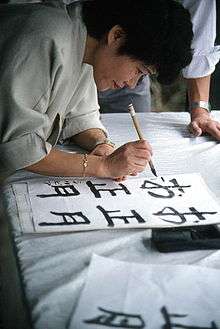Kakizome

Kakizome (書き初め, literally "first writing") is a Japanese term for the first calligraphy written at the beginning of a year, traditionally on January 2. Other terms include 吉書 (kissho), 試筆 (shihitsu) and 初硯 (hatsusuzuri).
Traditionally, kakizome was performed using ink rubbed with the first water drawn from the well on New Year's Day. Seated facing a favourable direction, people would write Chinese poetry containing auspicious words and phrases such as long life, spring, or perennial youth. These poems were then often burned.
In modern times, people often write out auspicious kanji rather than poems. School pupils up to senior high school are assigned kakizome as their winter holiday homework. Each year on January 5, several thousand calligraphers gather at the Nippon Budokan in Tokyo's Chiyoda-ku for a kakizome event that is widely covered by media.
The kakizome paper is usually burned on 14 January in the Sagicho festival. If the burning paper flies high, it is said that the person will be able to write a more fair hand.
References
- Gail Benjamin: Japanese Lessons: A Year in a Japanese School Through the Eyes of an American Anthropologist and Her Children. NYU Press 1998, ISBN 978-0-8147-1334-1, S.120
- New Year's In Japan - City News Urayasu, 2006-1-1, no. 105
External links
- Examples of children's kakizome
- Washi: Japanese Papermaking Workshop - Teacher's Guide des Robert C. Williams Museum (Georgia Tech), p. 22
- Kakizome contest in Tokyo - news notice on ABC
- The Newsletter of the Japanese Friendship Garden of Phoenix - Issue January/February 2009